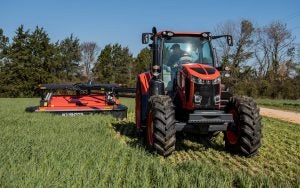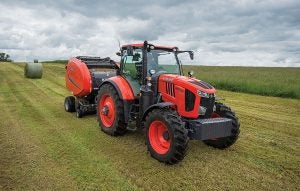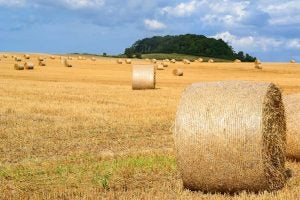From the month of May to late summer and early fall, hay baling is on the minds of many farmers. And during this stretch, the sight of workhorse tractors such as the Kubota M7 are common throughout our nation’s fields.
But baling hay, just like any other element of farming, requires a good deal of prep-work, and most families have spent the winter months greasing up the points on their mowers, rakes, and balers. For most American farmers, the first cut of hay coincides with Memorial Day weekend, and having a good To-Do List beforehand can make all the difference between having some leftover time for hamburgers and fun as opposed to not.

1. Weather forecast
Make hay while the sun shines, as the old saying goes. Excessive moisture in hay can be a very real danger, as anyone witnessing a barn fire can readily attest. When hay’s internal temperature exceeds 130 degrees Fahrenheit, it can spontaneously combust. Whether stacked in a barn in square bales, or lined up in rows, the effect can be equally dangerous. Heating occurs in hay above 15 percent moisture, hence the need to cut and bale the grasses dry. In addition to good clear weather, keep in mind the need to prep your conditioners and cutting equipment in advance.
2. Review your owners’ manuals for the equipment
We know you know how to use the equipment, but it doesn’t hurt to review every now and then. Better fuel efficiency results in lower costs and higher profits across all fields, and using the right set of lubricants can make a difference. As can pairing the right parts with the right equipment. But as practiced as every farmer is in the grand art of baling hay, remember that the hired help might not be. And a cursory review of the manuals can in fact serve as a reminder to …

3. Monitor the bale density
The time-tested method to ensure bale density is optimized is, of course, to get off the tractor and check. Moving too fast in the interest of time can result in mistakes being made, and tweaks not fixed or set while running. But the quality of the hay maintained in the bale is dependent on the density of the bale, and from a safety perspective, loose hay is more likely to heat and combust than when properly packed. In addition to keeping an eye on the baler’s density gauge, get out and kick the bales from time to time, with a general rule being that you shouldn’t be able to stick your fingers into it, and if you kick it, your foot should smart just a little.
4. Keep it clean
In reviewing your equipment manuals, keep cleanliness of the hay in mind. Set the baler pickup tines about an inch off the ground, ever remembering that hilly ground will be different than flat ground in this respect. Keeping your hay clean will lower ash percentages, which in turn improves quality and makes it easier to digest. Make sure the hay pickup flotation is set correctly so the pickup follows the contour of the ground and the tines aren’t digging into the dirt. A good review and check in advance will help as its easier to get replacement parts before the cutting than once you’re in the field.

5. Be safe
Baling hay is as American an activity as the apple pie and hot dogs. But keep safety in mind. Again, reviewing the manuals will help this regard. Watch out for workers wanting to ride high atop a wagon loaded with shaky square bales, and be sure that all wagons bound for a road have a Slow-Moving Vehicle emblem. Don’t forget to chock the wheels of wagons that can roll away, and it’s a good idea to pick up a 10-pound dry chemical (ABC) fire extinguisher just in case.
And when all that’s said and done, be sure to hook a radio up with some good farming music and be prepared to smell the freshly cut alfalfa, timothy, orchardgrass, or whatever you may grow. The bright and shiny tractor in the field, the hamburgers on a grill, and the generations of farmers celebrating the season all make for an image everyone is proud to see.
These baling tips were published on behalf of Kubota.



